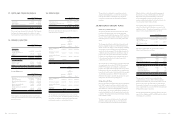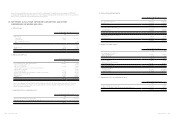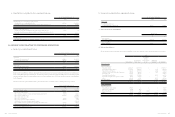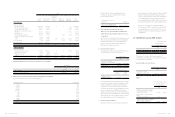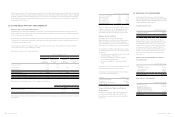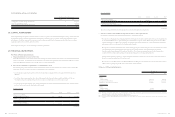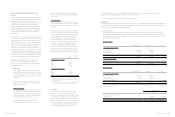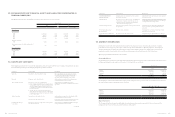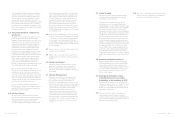HTC 2014 Annual Report Download - page 139
Download and view the complete annual report
Please find page 139 of the 2014 HTC annual report below. You can navigate through the pages in the report by either clicking on the pages listed below, or by using the keyword search tool below to find specific information within the annual report.
• Financial information Financial information •
274 275
Financial Risk Management Objectives and
Policies
The Company’s financial instruments mainly include equity
and debt investments, trade receivables, other receivables,
trade payables and other payables. The Company’s
Department of Financial and Accounting provides services
to the business, co-ordinates access to domestic and
international financial markets, monitors and manages the
financial risks relating to the operations of the Company
through analyzing the exposures by degree and magnitude
of risks. These risks include market risk, credit risk and
liquidity risk.
The Company sought to minimize the effects of these risks
by using derivative financial instruments and non-derivative
financial instruments to hedge risk exposures. The use of
financial derivatives was governed by the Company’s policies
approved by the board of directors, which provide written
principles on foreign exchange risk, interest rate risk, credit
risk, the use of financial derivatives and non-derivative
financial instruments, and the investment of excess liquidity.
Compliance with policies and exposure limits was reviewed
by the internal auditors on a continuous basis. The Company
did not enter into or trade financial instruments, including
derivative financial instruments, for speculative purposes.
The Department of Financial and Accounting reported
quarterly to the Company’s supervisory and board of
directors for monitoring risks and policies implemented to
mitigate risk exposures.
a. Market risk
The Company’s activities exposed it primarily to the
financial risks of changes in foreign currency exchange
rates. The Company entered into a variety of derivative
financial instruments to manage its exposure to foreign
currency risk.
There has been no change to the Company’s exposure
to market risks or the manner in which these risks were
managed and measured.
Foreign currency risk
The Company undertook transactions denominated in
foreign currencies; consequently, exposures to exchange
rate fluctuations arose. Exchange rate exposures were
managed within approved policy parameters utilizing
forward foreign exchange contracts.
The carrying amounts of the Company’s foreign
currency denominated monetary assets and monetary
The Company adopted a policy of only dealing with creditworthy counterparties and obtaining sufficient collateral, where
appropriate, as a means of mitigating the risk of financial loss from defaults.
The credit risk information of trade receivables are disclosed in the Note 11.
c. Liquidity risk
The Company manages liquidity risk to ensure that the Company possesses sufficient financial flexibility by maintaining adequate
reserves of cash and cash equivalents and reserve financing facilities, and also monitor liquidity risk of shortage of funds by the
maturity date of financial instruments and financial assets.
1) Liquidity risk tables
The following tables detail the Company’s remaining contractual maturity for its derivative financial liabilities and non-
derivative financial liabilities with agreed repayment periods. The tables had been drawn up based on the undiscounted cash
flows of financial liabilities from the earliest date on which the Company can be required to pay. The tables included both
interest and principal cash flows.
December 31, 2014
Less Than 3 Months 3 to 12 Months Over 1 Year
Non-derivative financial liabilities
Note and trade payables
Other payables
Other current liabilities
Guarantee deposits received
$ 14,037,502
12,648,166
60,588
-
$ 29,765,841
19,589,779
145,344
-
$ -
-
-
43,230
26,746,256 49,500,964 43,230
Derivative financial liabilities
Financial liabilities held for trading 22,424 - -
$ 26,768,680 $ 49,500,964 $ 43,230
December 31, 2013
Less Than 3 Months 3 to 12 Months Over 1 Year
Non-derivative financial liabilities
Note and trade payables
Other payables
Other current liabilities
Guarantee deposits received
$ 13,087,630
14,813,806
74,952
-
$ 33,188,221
23,219,193
184,577
-
$ -
-
-
256,415
$ 27,976,388 $ 56,591,991 $ 256,415
2) Bank credit limit
December 31
2014 2013
Unsecured bank general credit limit
Amount used
Amount unused
$ 1,638,476
43,623,999
$ 1,697,088
45,647,802
$ 45,262,475 $ 47,344,890
liabilities and of the derivatives exposing to foreign
currency risk at the end of the reporting period please
refer to Note 33.
Sensitivity analysis
The Company was mainly exposed to the Currency
United Stated dollars (“USD”), Currency Euro (“EUR”),
Currency Renminbi (“RMB”) and Currency Japanese
yen (“JPY”).
The following table details the Company’s sensitivity
to a 1% increase and decrease in the New Taiwan dollars
(“NTD”, the functional currency) against the relevant
foreign currencies. The sensitivity analysis includes
only outstanding foreign currency denominated
monetary items and the forward exchange contracts
were entered into cash flow hedges. A positive number
below indicates an increase in profit (loss) before
income tax or equity where the NTD strengthens 1%
against the relevant currency. For a 1% weakening of
the NTD against the relevant currency, there would be
a comparable impact on the profit (loss) before income
tax or equity, and the balances below would be negative.
Profit or
Loss (1)
Equity
(2)
Year ended December 31, 2014
USD
EUR
RMB
JPY
$ 40,670
(9,028)
(35,725)
2,324
$ -
-
-
-
Year ended December 31, 2013
USD
EUR
RMB
JPY
54,355
(18,430)
(24,673)
3,377
-
-
-
-
1) This was mainly attributable to the exposure outstanding on each
currency receivables and payables, which were not hedged at the end of
the reporting period.
2) This was mainly as a result of the changes in fair value of derivative
instruments designated as hedging instruments in cash flow hedges.
b. Credit risk
Credit risk refers to the risk that counterparty will
default on its contractual obligations resulting in
financial loss to the Company. As of December 31, 2014,
the Company’s maximum exposure to credit risk
which will cause a financial loss to the Company due to
failure to discharge an obligation by the counterparties
and the carrying amount of financial assets reported
on consolidated balance sheet. The Company does not
issue any financial guarantee involving credit risk.




